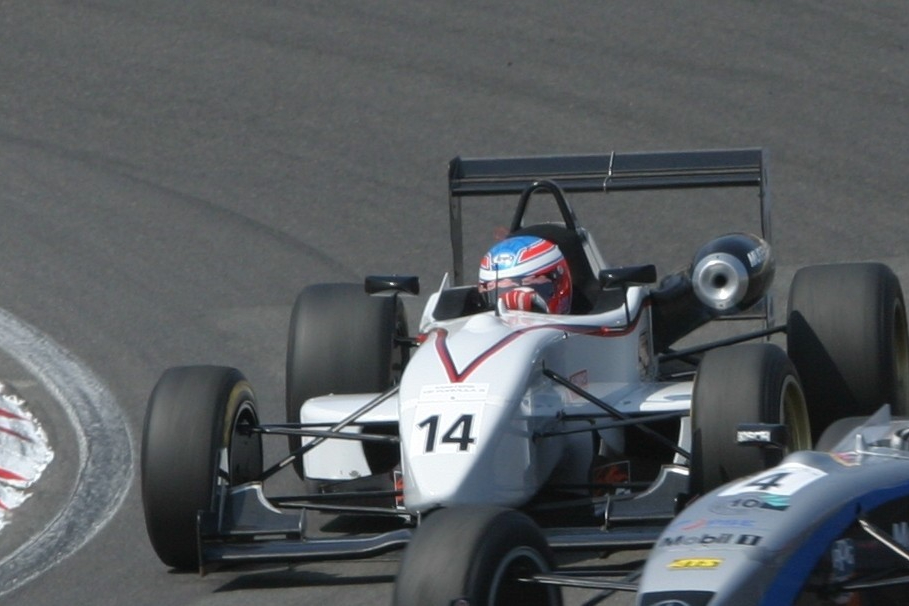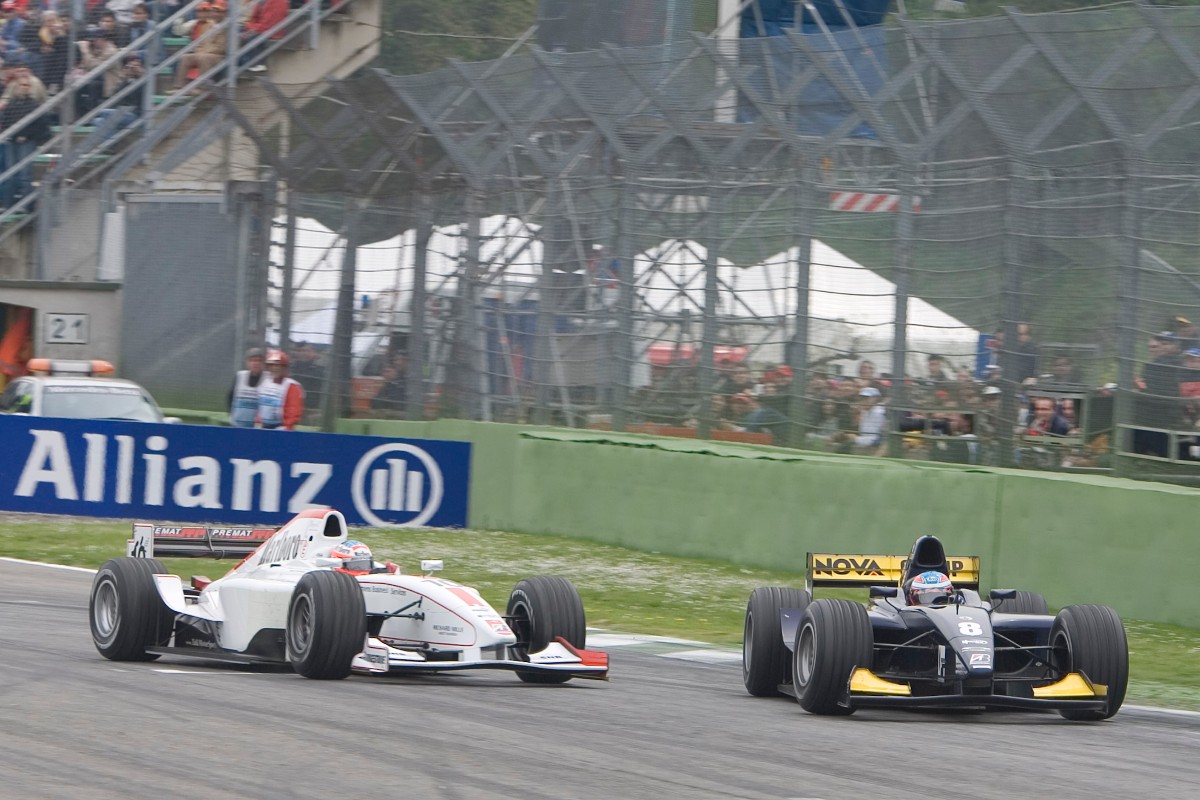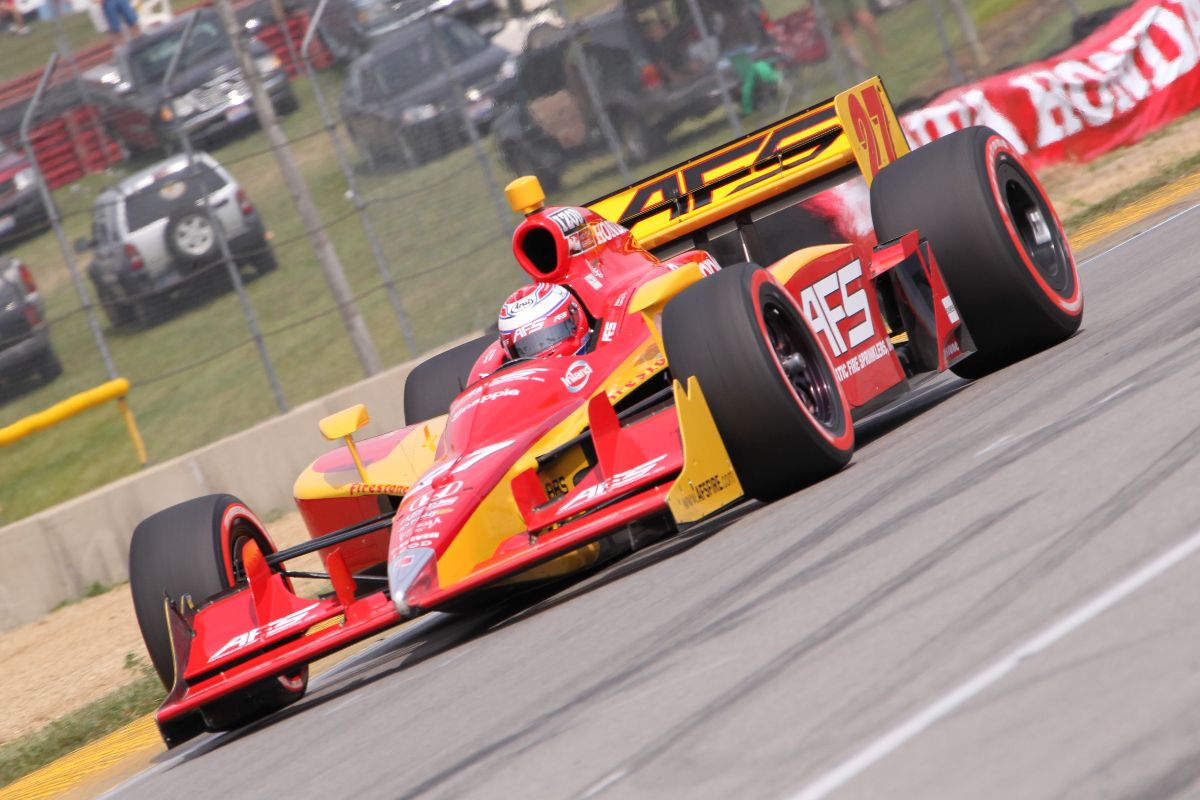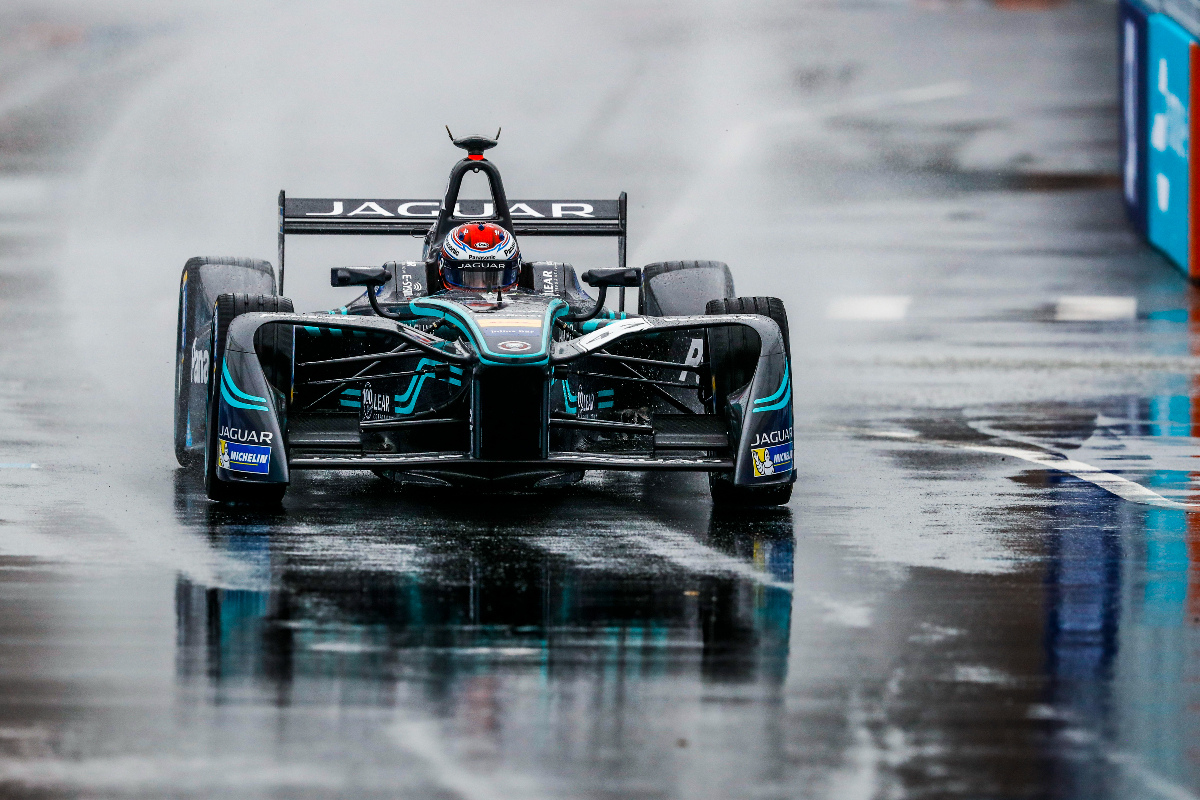
Photo: F3 Euro Series
Adam Carroll has driven a lot of different cars during his career, and won in a lot of them too. Ida Wood caught up with the Northern Irishman at Spa-Francorchamps to chat about his life in single-seaters
From Formula Renault Elf Campus to Formula E, Adam Carroll ticked off most of the single-seater cars out there as he carved his motorsport career. Now he primarily resides in sportscar racing, driving an Audi R8 LMS GT3 in International GT Open and a McLaren 570S GT4 in Britain’s GT Cup, and was NIO’s reserve driver for the 2020-21 FE season that concluded last weekend.
Before jumping to today’s action, Formula Scout wants to discuss his path to this point. His first car racing title came in the 2000 British Formula Ford Winter Series, and a year later he was third in the prestigious FFord Festival. From there he moved up to Formula 3, taking the British championship’s National class title as a rookie and winning the penultimate FIA European F3 Cup at Spa-Francorchamps as well as coming second in British F3 in his third year in the category.
That was enough to earn a step up to GP2 for its inaugural season, and Carroll was one of its’ first stars with his outlandish overtaking and underdog appeal. He became the first ever person to win a reversed-grid race in the secondary tier of single-seaters, was GP2’s first Monaco winner and beat his Super Nova team-mate – ex-Formula 1 driver Giorgio Pantano – to fifth in the standings as a rookie in 2005. The Northern Irishman also took in Formula Palmer Audi on his way up to GP2.
“Yeah, classic route,” Carroll laughs as he’s reminded of his junior single-seater path.
“And that’s kind of just what it was then. I’ve heard things like F2 budgets now are [in the millions]. I did my whole GP2 career, three seasons, for a total of €600,000. So I raced every year on less than a Formula Renault budget. The guy who backed me and sponsored me then, that’s pretty much what he could do. So it was an achievement in itself, but when you look back on it it wasn’t the right approach – you could never do it properly, you could never go to a title-winning team and have that consistent car to fight for the championship.”

Photo: GP2 Media Service
Carroll came eighth in his second GP2 season, and seventh in a part-time 2007 campaign which included two wins.
“Five wins and 14 podiums. But the car, that’s the thing. The difference is a team that wins the title is consistent. So on a bad weekend, you might be sixth. That’s a bad weekend. Generally their average is just really high. The problem with a midfield team is they can still at the odd time give you a quick car, but their average when they have a bad day is really bad.
“You’re not sixth, you’re 18th. Just absolutely nowhere. So that fluctuation and lack of consistency makes it really difficult to actually, as a driver, show what you can do and build the momentum. It wasn’t until A1GP that I got that consistency. That Ferrari A1GP car was a nice car to drive. Precise, my type of car, loads of downforce, loads of grip. And I had the right team together.”
More than his European Cup or GP2 heroics, Carroll is best known of course for winning the ‘World Cup of Motorsport’: A1GP.
The nation-based contest initially used a Lola car, before moving to a chassis based on Ferrari’s dominant F2004 car and powered by a 4.5-litre Ferrari V8 engine. After a brief move into the DTM, Carroll moved into A1GP at the end of 2007 with the Status Grand Prix-run Team Ireland. He made the podium on his debut, claimed his first win at Mexico City in March of the next year and then raised his game for the 2008-09 season with five wins including a double in the Brands Hatch finale.
“A1GP was a step. Once you’d cracked into that, you were in a paid drive. So you were out of the whole trap: scrape money together to get a seat to actually get a drive.
“That whole mentality is quite hard, unless you’ve got the right management and people looking after you, as you just get totally lost.”
So what made Team Ireland the consistent force Carroll needed to become A1GP champion?

Photo: GP2 Media Service
“Just the people that were involved. The people who were involved in that year never continued on with it. It was a one-off year. Dave O’Neill [latterly of Virgin and Haas in F1] was team manager, he was able to put together really experienced guys. We had a new race engineer, Gerry Hughes [latterly of NIO], tonnes of experience. I had loads of experience from GP2 and all the rest of it, one year in the Lola car. So it was just that fit that allowed you to hit the ground running with a really good base, and then build on it. And that’s just how it works.
“Usually you know you’re in good shape when you do your first test and everything seems to be pretty good and then when you’re scratching your head and everybody’s like ‘what’s going on’, you know you’re in for a bit of a fight.
“The engineers, the mechanics I had were super experienced with the pitstops, they were just mega in the pitstops. It was such an aggressive team. It was like you just would not have wanted to have had a bar fight with them, they were just so aggressive. But really experienced and they all wanted to win. And we were able to channel that and actually make it happen. It’s just a shame how it ended, because you could have taken that group of people and gone to IndyCar and done unbelievably with that. You could have gone into sportscars, you could have wound up – you could have just held on to that group. After that it was just a completely different thing for Status, it was nothing [like before].”
The Canadian-registered outfit, based near Silverstone, moved into GP3 with success and then had one winning year in GP2 before leaving racing. Status may not have stayed in professional racing, but Carroll did and had a near-miss with F1 for 2010.
“Moving into F1 with the new teams, yes there was a lot of [chances] if certain things had had happened, then I was close to, well, I would have been in one of the new teams,” Carroll recalls of his F1 experience.
“But I did 11 days for Honda, so I did 4000km in F1 testing. V10s to start, which were the beasts. 19,000-20,000 rpm, 605kg, they were doing almost the same laptimes as F1 now but on grooved tyres.”

Photo: Ron McQueeney / IndyCar
When a 2010 F1 seat didn’t materialise, an IndyCar avenue opened for Carroll.
“I did two IndyCar races for Andretti Autosport, and that was off the back of A1GP. I got to know [team boss] Michael Andretti, as they ran Team USA. So I got to know him a little bit, and I was really hoping that was going to be a big break. I got the two races with them, was looking to hopefully continue on as a full season the year after; proper contract, proper programme and everything. And right at the last minute, the sponsorship they needed to make it happen, they were short. So that was it for me. It was about $1.5 million short.”
Andretti had worked to bring him into the team, and Carroll estimates the cost to run in a road course race was $220,000.
“IndyCar ranged from $210,000 to, at a team that had a big name, paid properly, had everything in place, $450,000-500,000 a weekend. That’s the difference. It’s nothing compared to back in the day.
“[Since the 1990s] everything has gone up. So the cost of running it, the mechanic salary was doubled, the chief engineer salary was doubled, and the driver salary was like 60% less. So the top boys, which is still alright, they’re earning probably on a base salary of around $2 million. I’m sure Scott Dixon and people are even way above that. But a million dollar salary is obviously loads of money, but guys can talk type of that stuff. It was $5-7 million back in the day.
“A1GP had really good prize money, it had proper drivers who at our level paid what you meant to be paid, it had great coverage, the racing was brilliant, the cars were brilliant. Loads of people turned up. The tracks you went to were full. There was maybe 40-50,000 people in some cases. The atmosphere was brilliant. And my understanding was that the championship actually started to make money. But the financial crash had just wrote it up. They’d spent $60 million buying and doing the Ferrari deal, spending all that money, that generated something like $30 million. And then the crash came along and there was just a big hole and that was it.

Photo: GP2 Media Service
“The concept was honestly quite amazing. One of the few things I’ve seen – obviously GT racing has gone massive, with the GT World Cup, GT3’s got so big in general. But talking single-seaters, the only other thing that I’ve seen that’s come and actually stayed and got huge is Formula E.”
After his IndyCar dream fell apart, Carroll picked up a few starts – and a win – in the F3000-based Auto GP series, returned to GP2 and cameoed in FR3.5 before making his sportscar switch. He then made a surprise and much-welcomed single-seater return when Jaguar signed him as it joined FE for the 2016-17 season.
A best finish of eighth and best qualifying result of seventh wasn’t enough for Carroll to retain his seat, but he returned to the FE fray with NIO at the start of this year. So what has he done in his recent reserve role in the series?
“Well, a reserve driver – if you wanted to, you wouldn’t have to do a whole lot, really,” he laughs.
“I get given a few jobs. You want to try to help, keep an eye out, be thinking if you’ve seen or heard anything. Make sure on social media you’re creating a little bit of content, things like that. Listening a lot, because you’ve got to stay on top of everything. You’re in all the debriefs, you’re trying to take as much information in as possible. I got the job of weather man for one race weekend, so just kept on top of the weather. That was Valencia. Because I think they were one man down, so you just jump in and help out. So for me, you need to try and just help as much as possible.
“FE is unique. It’s very complex, with the technology that’s in them. Since I did it with Jaguar, the basics are still the same. But it’s just moved on in terms of you have the fly-by-wire braking, the software, the electronic side is really quite advanced, like super advanced now. It’s completely open.
“Certain teams have different kind of philosophies, different [technical] language nearly. How they talk about what they use to explain, or the terminology for things, can be really quite different. I think in general that complicated and technically advanced championships, teams can go about stuff quite a different way actually.

Photo: FIA Formula E
“F1 has proved that in 2021 with drivers who have gone to other teams and have actually struggled. They’re struggling to either adapt to the car, or not just the car, it’s the whole process. It’s really quite different. That’s always quite surprising and can be good as well, but sometimes if you go another direction and it’s just done better in a different way.
“But to drive the cars, I did test the Gen2 car last year, that’s how the whole FE reserve driver role came around. And they’ve definitely moved on a little bit. So as long as it’s working as you hope it to be, it feels like a normal car honestly. It’s not the fastest, but once you go to the street tracks that you’re on, they’re still fast and bumpy, the cars are not easy to drive.
“They’re a little bit unpredictable. So you just end up not really too sure what’s going to happen, and you can see that from the unpredictability, and sometimes a driver will just make a what looks like a pretty silly mistake but there’s a lot more going on in the background than you would [imagine].”
In the Valencia E-Prix weekend that Carroll added ‘weather man’ to his list of tasks, one of the races was controlled from the front by BMW Andretti’s Jake Dennis despite it being tipped as being unfavourable to stay out front when managing energy.
“I mean when you’re so tight on energy, as long as you’re running at the right pace at the front then you can control it,” Carroll explains.
“So [Dennis] just had good pace. The slipstream at Valencia was, people didn’t really want to break that, or lead actually. So the guy in second place wanted to try to sit there for as long as possible. So I think if [Mahindra’s] Alex Lynn hadn’t have been taken out [of the equation from second], that would have been a different outcome for me. Taking nothing away from Jake, he did a brilliant job. But I think Alex was able to save that little tiny bit more energy all the time sitting behind in the slipstream, and then he could have used that later on. Because you’re working so fine a limits, that any tiny little bit of energy you can save will help you later on in the race.”

Photo: Fotospeedy
The complexity of FE makes it “refreshing” when Carroll hops back to sportscar duties, but the former does fascinate him.
“I think FE is really all about software. Most of the biggest percentage gains are in the software, you’re not really talking about a mechanical balance shift. It’s hugely how the software effects the car balance and what you can do to improve that. So it’s really quite different. I’d say FE is three-dimensional racing, it’s another element.
“And what the software and computer side does is it’s another tuning tool to make your car faster or slow. You can get it right and all the software works and it’s good, but you can also get it quite badly wrong. And that’s on top of just the mechanical car with your powertrain and your springs and dampers and rideheight, and everything else that you normally would just be trying to deal with. So it really adds another dimension to it, and it’s not easy to take it all in and make it work. Maybe that’s why it does fluctuate so much. Because it’s just so hard to kind of get it right all the time.
“So in a GT3 car, for me anyway, it’s nice to just come back and just drive a more pure mechanical car. And these cars are fast now. GT3s are, it’s only six seconds off a F3 around Spa? So for 800-kilogram cars it’s quite impressive. And they’re enjoyable to drive. In the car you have enough information. You have tyre pressures, pretty much that’s all you kind of need. You’re driving flatout all the time, and you keep an eye on your pressures with the live tyre pressures on your dash. Which is good because sometimes if you start to be a bit aggressive or they’re overheating, you might need to just keep them in the window that you’re working to. But apart from that you just get on with it and drive as fast as you can.”
More on Formula E
What we’d want to see from a FE feeder series / FE teams in discussion to create support series
Why FE is a whole new ball game for single-seater stars
How a 1990s Renault design study pre-empted FE